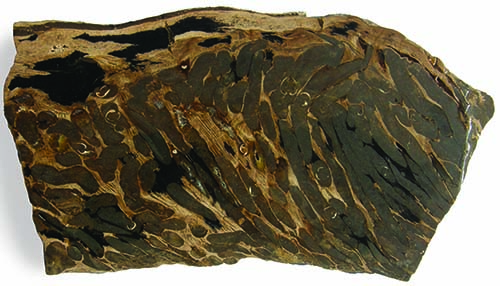
Teredo petrified wood is a peculiar petrified wood that resembles Swiss cheese with its many holes and is the state fossil of North Dakota. It is not as smooth as Sycamore petrified wood and not as elusive as Hell’s Canyon Petrified Wood.
Following Trends
While it may have just one rockhound symbol, North Dakota can take pride in knowing it was one of the early states to designate such a symbol. Rockhound author June Culp Zeitner, encouraged the practice starting in the early 1960s, with articles in bulletins of the American and Midwest Federations of Mineralogical Societies. Fanned by June’s efforts, five states designated a state mineral, rock, or fossil in 1965.
Two more states followed suit in 1966, then eight more — including North Dakota—jumped on the bandwagon in 1967. Now, nearly every state in the union has at least one rockhound symbol.
Teredo Petrified Wood
Teredo petrified wood gives fossil collectors a twofer. It is both a fossil and a trace fossil. What we commonly call a fossil is basically a body fossil. It’s a fossilized body part such as a tooth, skull, bone or shell. A trace fossil is just what the name implies, it’s a trace of a creature that lived long ago, for example, footprints, scat or burrows. Teredo petrified wood is a fossil of varied wood species (ginkgo, metasequoia, bald cypress, etc.).
During the Paleocene Epoch, 60 million years ago, logs of such trees became driftwood, floating in an inland ocean called the Cannonball Sea. Such logs served as a home base for small, worm-like Teredo clams that bored into them with rasping shells that left long tunnels or trace fossils. These subsequently filled with sediments of what has been named the Cannonball formation.
This formation represents the last inland sea to cover North Dakota. Its sediments may be found in the areas immediately around and southwest of the cities of Bismarck and Mandan.
Revealing Sea Life
When petrified Teredo wood is cut and slabbed, you often can see outlines of the clamshells as tiny white crescents within the elongated in-filled tubes they carved. Similar petrified wood from Australia is commonly referred to as peanut wood.
Throughout history, sailors have cursed such so-called shipworms for the damage they did to wooden sailing vessels. Today, fossil collectors appreciate the intricate designs they left in petrified wood.
This story about Teredo petrified wood previously appeared in Rock & Gem magazine. Click here to subscribe! Story by Jim Brace-Thompson.















